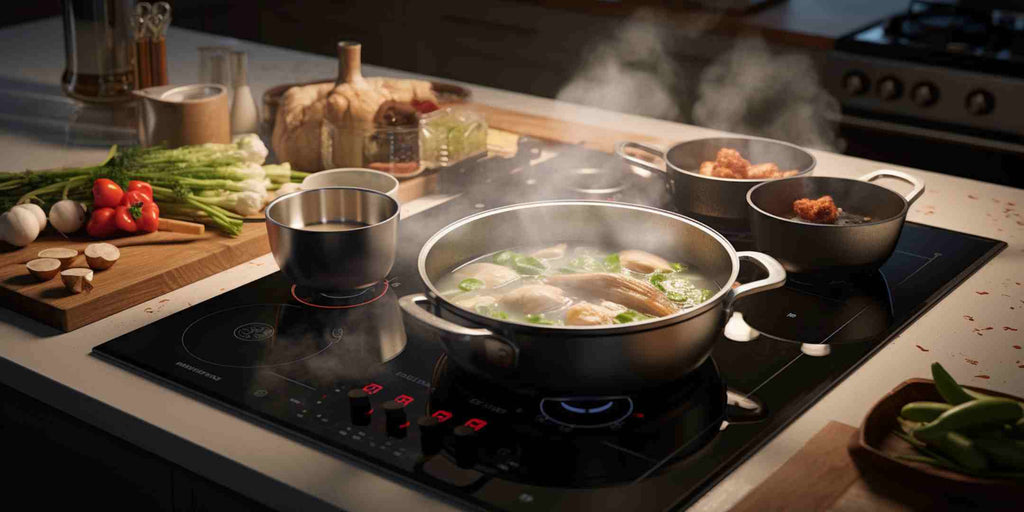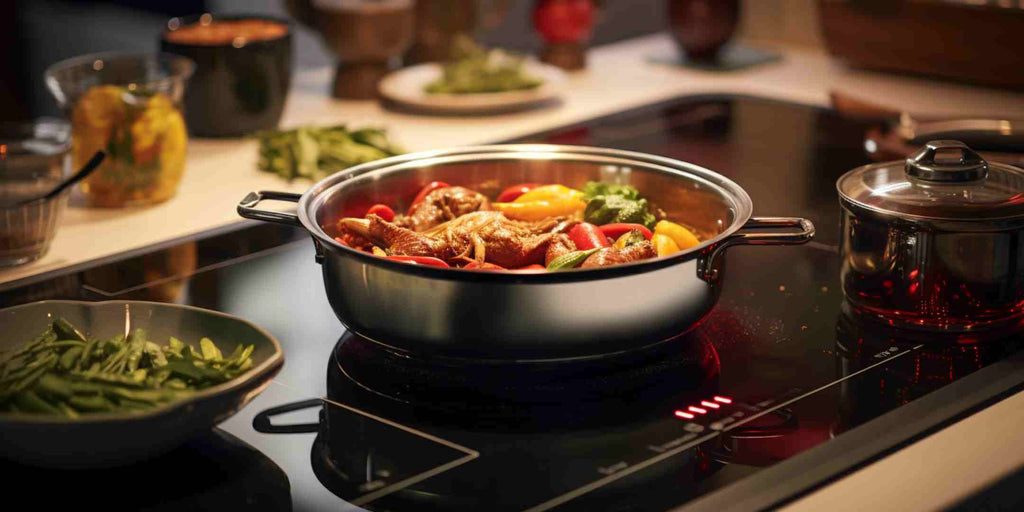Have you ever noticed how our city is buzzing with the aromas of inviting broths and bubbling pots?
Hotpot's more than just food here; it's a cherished ritual. You might be focused on the mix-ins or broth, but have you considered the burner below? That little guy is the real game-changer!
Believe it or not, the correct burner is vital to getting that perfect, soul-warming hotpot experience.
So, let’s dive deeper and see what’s cooking beneath the pot!
Hotpot Singapore Burner Types
1. Gas Burners
Pros:
Instant Heat: One of the significant advantages of gas burners is their ability to provide immediate heat. No, wait around; light it up, and you’re ready.
Portability: Gas burners are often compact and designed for mobility. Whether having a hotpot on your balcony or at a friend's place, these burners are easy to move.
Cons:
Gas Refills: While efficient, one can’t forget the periodic need for gas refills, which can be both cumbersome and an added expense.
2. Electric Burners
Pros:
Convenience: Simply plug it in, and you're set—no need to worry about gas refills or external fuel sources.
Consistent Heat: Electric burners provide steady, constant heat, which can be great for maintaining the perfect simmer in your hotpot.
Cons:
Speed: They take longer to heat up than gas burners. Patience is key here.
3. Induction Burners
Pros:
Efficiency: Induction burners utilise magnetic fields to heat pots and pans directly, making them incredibly efficient and quick to warm up.
Safety: With induction, the cooking surface remains relatively calm, reducing the risks of burns. Plus, no open flame means it’s safer for homes with children or pets.
Cons:
Cookware Limitations: They require magnetic cookware, like cast iron or some stainless steel varieties. So, not all pots or pans will work here.
4. Infrared Burners
Pros:
Quick Heating: Infrared burners utilise electromagnetic radiation for cooking, translating to super-fast heating times.
Even Cooking: Say goodbye to unevenly cooked ingredients. The heat distribution is generally uniform with infrared technology.
Cons:
Energy Consumption: They can consume much energy, which might not be the most cost-effective option in the long run.
Adjustability: Getting the precise temperature can sometimes be tricky, making dishes that need varying heat levels challenging.
Factors to Consider When Buying a Hotpot Burner

1. Size & Portability
Size does matter, especially when it comes to burners. Think about where you'll be placing your burner. Do you have a spacious dining table or a cosy kitchen countertop? The size of your burner should fit snugly into your designated space without feeling overcrowded. But there's another side to this coin – portability. If you love taking the hotpot experience to different spots, maybe even outdoors, you'd want a burner that's easy to carry around. So, consider a balance between size and the ability to transport it with ease.
2. Heat Control
Every ingredient in your hotpot has its perfect cooking temperature. Be it delicate slices of fish or hearty chunks of beef, each requires a different heat level. Additionally, your hotpot session's beginning, middle, and end stages might need varying heat intensities. Thus, having a burner with adjustable heat settings isn't just a good-to-have; it's a must. Look for burners that easily tweak the temperature so every bite is cooked to perfection.
3. Safety Features
Safety should never take the backseat. Here’s what you should be on the lookout for:
Stability: Ensure the burner has a sturdy base to avoid any tipping incidents.
Cool-touch handles: These are especially important for portability; you don't want to risk burns while moving it.
Auto shut-off: A feature that automatically turns off the burner after a set time can be a lifesaver, especially if you're forgetful.
Flame guards (for gas burners): These can prevent sudden flare-ups and keep the flame consistent.
4. Durability & Brand Reputation
You don’t invest in a burner every day. It’s a commitment to countless delicious hotpot sessions. Hence, the longevity of the product is paramount. But how can you gauge that? One way is by considering well-known brands. A brand's reputation, built over years of consistent performance, can be a reliable indicator.
Check reviews, ask around, and even see if the brand offers any warranties or guarantees. Remember, a durable burner not only saves money in the long run but also ensures consistent cooking sessions without hiccups.
Megafurniture Singapore’s Top Burner Picks for Hotpot (Brands)
1. Toyomi
Description: A trusted name in the culinary world, Toyomi has consistently delivered quality across its range of burners. Known for their durable build and efficient performance, they provide an uncompromised hotpot experience.
Price Range: SGD 54-140
Best For: Those looking for a perfect blend of tradition and modernity. Whether you’re leaning towards gas or electric burners, Toyomi has something to cater to every hotpot enthusiast's needs.
2. Europace
Description: Europace prides itself on introducing innovation to the kitchen. Their burners, whether induction or gas, are crafted with the latest technology, ensuring safety, efficiency, and a sleek design.
Price Range: SGD 130-140
Best For: Individuals with a keen eye for sophisticated design paired with advanced technology. Europace should be on your radar if you're about maximising safety and efficiency.
Maintaining Your Hotpot Burner for Longevity (Essential Tips)

1. Cleaning After Every Use
For Gas Burners: Wipe down the surface with a damp cloth once cooled. For stubborn spots, use a mild detergent. Ensure all gas outlets are clear of obstructions.
For Electric and Induction Burners: Wipe the surface with a soft, damp cloth. Avoid abrasive scrubbers to prevent scratches.
2. Deep Cleaning Periodically
For Gas Burners: Detach removable parts and soak them in warm soapy water. Use a soft brush to scrub off any residue.
For Electric and Induction Burners: Wipe down with vinegar and water to break down any built-up grease or stains.
3. Proper Storage
Store your burner in a dry, cool place away from direct sunlight. This prevents any wear and tear from environmental factors.
If your burner is portable, consider investing in a protective case or cover to shield it from dust and potential damage.
4. Avoid Overloading
Always adhere to the manufacturer's guidelines regarding weight limits. Overloading can strain the burner and decrease its lifespan.
5. Regularly Check for Wear and Tear
Periodically inspect cords and connectors for any signs of damage. For gas burners, ensure no gas leaks and that the flame is even and blue.
6. Use the Right Cookware
Especially for induction burners, ensure your pots and pans are compatible. Inappropriate cookware can damage the burner and decrease its efficiency.
7. Protect from Spills
While some spills are inevitable during a bustling hotpot session, quickly clean up, especially on electric or induction burners, to prevent long-term stains or damage.
8. Refer to the Manual
Your burner's manual isn’t just a booklet to be tossed aside. It often contains specific maintenance tips and troubleshooting guidelines tailored to your model.
Key Takeaway:
The soul of an ultimate hotpot Singapore experience lies in the ingredients you select, the company you keep, and the burner that simmers your pot to perfection. The right burner does more than just heat your food; it ensures even cooking, offers adjustable temperatures for different ingredients, and provides an ambience integral to the whole experience.
As you cherish those delightful moments around the table, sharing stories, laughter, and delicious bites, know that the burner plays an understated yet pivotal role in creating that magic. And when it's about choosing the best, why compromise?
Bonus Treat: Hotpot Heat Level Control Guide for Perfect Hotpot Sessions
1. Starting – High Heat
Purpose: To bring the broth to a boil quickly.
Duration: Until the broth starts boiling vigorously.
Tip: Once your broth is boiling, add your first round of ingredients, like tougher meats or root vegetables, which take longer to cook.
2. Adding Ingredients – Medium-High Heat
Purpose: To maintain a strong simmer.
Duration: While adding meats, seafood, and vegetables.
Tip: Keep an eye on the pot. You want a steady simmer, not a full boil, to avoid overcooking delicate ingredients.
3. Slow Cooking – Medium Heat
Purpose: Let ingredients like thinly sliced meats, mushrooms, or tofu cook gently.
Duration: Until the ingredients are cooked to your satisfaction.
Tip: Some ingredients, especially thinly sliced meats, cook very quickly. They might need a minute or two!
4. Winding Down – Low Heat
Purpose: To keep the hotpot warm without further cooking the ingredients.
Duration: As you near the end of your meal.
Tip: This is an excellent time to add ingredients like noodles or rice cakes, which can soak up the rich flavours of the broth.
5. Final Touches – Off Heat
Purpose: To let diners enjoy the remaining broth without the distraction of the flame or further cooking.
Duration: At the very end of your meal.
Tip: If you have leftover broth, consider turning it into a base for another dish or soup.
Bonus Tips:
Adjust Frequently: The number of ingredients in the pot can influence the temperature. Don't hesitate to adjust the heat as needed throughout the session.
Know Your Ingredients: Delicate items like certain seafood or thin veggies might need lower heat than hearty meats.
Safety First: Ensure you're seated safely from the burner and take necessary precautions, especially if children are around.








